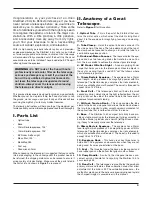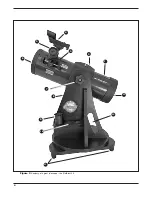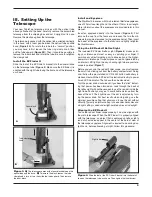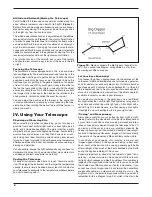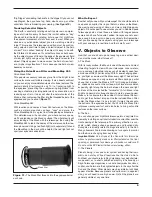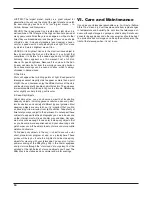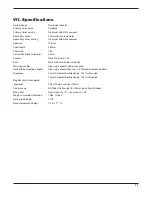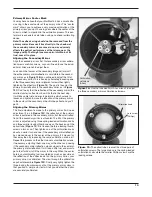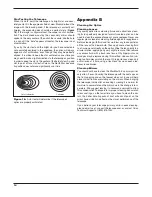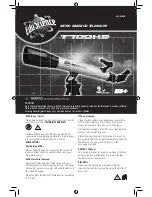
7
Replacing the Battery
Replacement 3-volt lithium (CR-2032) batteries are available
from many retail outlets. To replace the dead battery, use a
small Phillips head screwdriver to remove the battery cover
(
Figure 8A)
. Then carefully pull back on the retaining clip and
shake out the old battery. Do not over-bend the retaining clip.
Then slide the new battery under the retaining clip with the pos-
itive (+) side facing the clip as shown (
Figure 8B
).
III. Operating the
Telescope
Eyepiece Selection
By using eyepieces of different focal lengths, it is possible
to attain different magnifications with your telescope. That’s
because the magnifying power of a telescope is dependent on
both the focal length of the telescope and of the eyepiece being
used with it.
To calculate the magnification of a telescope-eyepiece com-
bination, simply divide the focal length of the telescope by the
focal length of the eyepiece.
Focal Length of Telescope (mm)
Magnification =
Focal Length of Eyepiece (mm)
So, for example, the StarBlast 4.5 has a focal length of 450mm.
When used with the 20mm eyepiece, the resulting magnifica-
tion is 22.5x.
450mm
= 22.5x
20mm
When using the 10mm eyepiece, the magnification is 45x.
450mm
= 45x
10mm
The 20mm eyepiece is great for low power, wide field viewing,
while the 10mm eyepiece is suited for higher-power observa-
tion. Other eyepieces can be used to achieve even higher pow-
ers. It is quite common for an observer to own five or more eye-
pieces to access a wide range of magnifications. An optional 2x
Barlow lens is another great accessory to have. It doubles the
magnifying power of any eyepiece it is used with.
We recommend starting a viewing session by inserting your
lowest-power (longest focal length) eyepiece to locate and cen-
ter the target object. Low magnification yields a wide field of
view, which shows a larger area of sky in the eyepiece. This
makes finding and centering an object much easier. Trying to
find and center objects with a high power (narrow field of view)
eyepiece is like trying to find a needle in a haystack! Once
you’ve centered the object in the eyepiece, you can switch to
a higher magnification (shorter focal length) eyepiece, if you
wish. This is recommended for small and bright objects, like
planets and double stars. The Moon also takes higher magnifi-
cations well. The best rule of thumb with eyepiece selection is
to start with a low power, wide-field eyepiece, and then work
your way up in magnification. If the object looks better, try an
even higher magnification eyepiece. If the object looks worse,
then back off the magnification a little by using a lower-power
eyepiece.
Magnification Limits
Every telescope has a useful magnification limit of about 2x
per millimeter of aperture. This translates to a limit of 228x for
the StarBlast 4.5 (4.5” equates to 114mm aperture). Some tele-
scope manufacturers will use misleading claims of ultra-high
magnifications: “See distant galaxies at 640X!” While such
magnifications are technically possible, the actual image at that
magnification would be a dim, indistinct blur. Low and moder-
ate magnifications are what give the best views. A small, but
bright and crisply detailed image is always better than a dim,
blurry, over-magnified one.
Image Orientation
The image in the eyepiece will appear rotated (upside down)
in the StarBlast 4.5. This is normal for reflector telescopes. But
this is also why reflector telescopes are not recommended for
daytime terrestrial use. For astronomical viewing the orienta-
tion of the image matters little, as there is no “right side up” in
space!
On or Off the Ground? Your Choice
One of the great qualities of the StarBlast 4.5 Astro Reflector is
its conveniently compact, portable size. The cutout in the side
panel makes a perfect carrying handle for taking the StarBlast
wherever you want to go. You may find that the most comfort-
able way to use the telescope is while sitting down or kneeling
on the ground next to it. If you wish to raise the telescope off the
ground a bit so that it can be used while standing or sitting in a
chair, then setting it on a platform such as a milk crate, a camp-
ing table, or a picnic table might be just the ticket.
Figure 9.
The StarBlast has two axes of motion: altitude (up/
down) and azimuth (left/right).
Altitude
Azimuth



